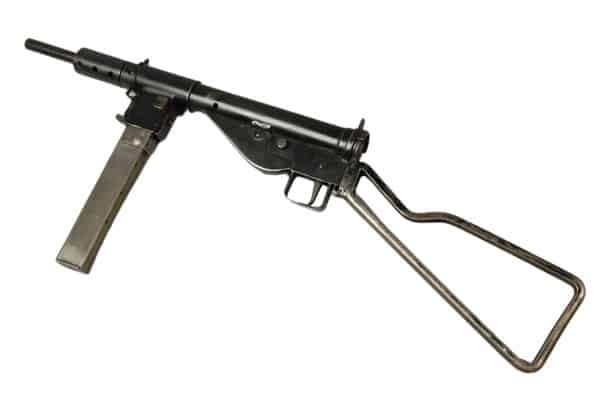
Introduction to the Sten Gun
The Second World War ignited a period of rapid technological and industrial innovation, particularly in the field of small arms development. Among the most iconic and influential weapons of this era was the Sten gun, a British submachine gun that epitomized simplicity, cost-effectiveness, and battlefield practicality. Developed as a response to a dire need for mass-produced firearms, the Sten became a hallmark of British and Commonwealth forces, as well as resistance movements throughout Europe.
Despite its crude design and rough manufacturing, the Sten played a critical role in equipping soldiers, commandos, and partisans during World War II and later conflicts, earning its place in military history.
Origins and Predecessors
The genesis of the Sten gun can be traced directly to Britain's desperate situation following the Dunkirk evacuation in 1940. With the British Expeditionary Force (BEF) forced to abandon vast quantities of weapons in France, the British Army faced an acute shortage of small arms just as the threat of a German invasion loomed under Operation Sea Lion.
At that time, the British military relied on a mix of small arms, including:
- The Lee-Enfield rifle – excellent for precision shooting but impractical for close combat.
- The Thompson submachine gun – powerful but expensive and slow to manufacture.
- The Lanchester submachine gun – a well-made but heavy and costly copy of the German MP 28, issued mainly to the Royal Navy.
The need for an inexpensive, easily manufactured submachine gun became paramount. Unlike the Lanchester or Thompson, the new weapon had to prioritize speed of production over refinements in craftsmanship. This requirement led directly to the Sten gun.
Development and Design
The Sten gun was the brainchild of Major Reginald V. Shepherd and Harold Turpin, two engineers working under the British Ministry of Supply. The name "Sten" is derived from:
- S for Shepherd
- T for Turpin
- EN for Enfield, the location of the Royal Small Arms Factory.
The design brief was straightforward: create a submachine gun that was simple, cheap, and quick to produce, while still being effective in combat. The result was a blowback-operated, open-bolt firearm chambered for the 9×19mm Parabellum cartridge, a widely used round that was also compatible with German submachine guns like the MP 40.
Key design features of the Sten included:
- Minimal machining – Most components were stamped metal, with only basic welding required.
- Open-bolt operation – The bolt remained in the open position when ready to fire, reducing complexity but increasing the risk of accidental discharge.
- Side-mounted magazine – The 32-round detachable box magazine, positioned on the left side, allowed for a compact weapon design but was prone to feeding issues.
- Cylindrical receiver and barrel shroud – Reducing weight and simplifying manufacture.
- Fixed firing pin – Simplifying the trigger mechanism.
The result was a weapon that could be mass-produced at a fraction of the cost of alternatives. A single Sten Mark II cost only $10–12 (USD) to produce, compared to $200 for a Thompson.
Manufacture and Production
The simplicity of the Sten made it ideal for mass production across numerous facilities. The primary manufacturers were:
- Royal Small Arms Factory (RSAF) Enfield
- Birmingham Small Arms Company (BSA)
- Royal Ordnance Factories (ROF)
- Long Branch Arsenal (Canada)
However, due to its simple construction, Sten guns were also produced in smaller workshops, both legally and clandestinely. Resistance groups across France, Poland, Norway, and Yugoslavia were able to manufacture homemade copies, further spreading its impact.
Between 1941 and 1945, nearly 4 million Sten guns were produced. The most common variant, the Mark II, alone accounted for over 2 million units.
Variants of the Sten
There were six major variants of the Sten, each with unique modifications:
- Sten Mk I (1941) – The original model, featuring a wooden foregrip and a flash suppressor.
- Sten Mk II (1941–1945) – The most common version, known for its extreme simplicity and detachable barrel.
- Sten Mk III (1942–1943) – A cost-reduced version with a fixed barrel, made by Lines Bros Ltd.
- Sten Mk IV (Experimental) – A rare, lightweight version designed for airborne troops but never mass-produced.
- Sten Mk V (1944–1945) – A refined version with a wooden stock, intended for paratroopers and commandos.
- Sten Mk VI (1944–1945) – A silenced version, used primarily by SOE (Special Operations Executive) and resistance fighters.
Combat Performance and Cartridges
The Sten was chambered in 9×19mm Parabellum, a widely available and effective pistol-caliber round. It had:
- Rate of fire: ~500 rounds per minute.
- Effective range: Typically 50–100 meters (practical combat use), though sights were marked for 200 meters.
- Magazine: 32-round side-feeding box magazine (often loaded with only 28–30 rounds to prevent jams).
Strengths of the Sten
- Low cost – Enabled mass production at a fraction of the price of alternatives.
- Compact and lightweight – At 7.1 lbs (3.2 kg), it was easy to carry.
- Common ammunition – Used the same ammo as captured German MP 40s.
- Ideal for urban combat – Short length made it effective in close-quarters battles.
Weaknesses of the Sten
- Magazine reliability issues – The single-feed design often led to jamming.
- Crude sights – Accuracy suffered beyond 100 meters.
- Open-bolt risk – Could fire accidentally if dropped.
- Build quality variations – Poor tolerances in some production runs.
Comparative Analysis
How the Sten Compared to Other WWII Submachine Guns
| Weapon | Cartridge | Rate of Fire | Effective Range | Cost per Unit |
|---|---|---|---|---|
| Sten Mk II | 9×19mm | ~500 RPM | 50–100 m | ~$10–12 |
| MP 40 | 9×19mm | ~500 RPM | 100–150 m | ~$100 |
| M3 Grease Gun | .45 ACP | ~450 RPM | 50–100 m | ~$20 |
| PPSh-41 | 7.62×25mm | ~900 RPM | 100–200 m | ~$40 |
The Sten was the cheapest and fastest to produce but lacked the refined engineering of the MP 40 or the raw firepower of the PPSh-41.
Legacy of the Sten
Even after World War II, the Sten saw extensive use in:
- Korean War (1950–1953)
- Malayan Emergency (1948–1960)
- Israel's War of Independence (1947–1949)
- Indochina and Vietnam Wars
It remained in service with various paramilitary forces into the 1970s before being phased out in favor of the Sterling submachine gun.
Conclusion
The Sten gun was a product of necessity, embodying wartime pragmatism. While crude and imperfect, its affordability and ease of production made it one of the most widely used submachine guns of World War II. Despite its flaws, the Sten proved that sometimes, simplicity and efficiency are more valuable than precision craftsmanship. It remains an iconic symbol of British ingenuity in the face of adversity.
Consider joining a forum to discuss this firearm. Such a forum can be found here.
Read more about the Sten here:



If you know of any forums or sites that should be referenced on this listing, please let us know here.




